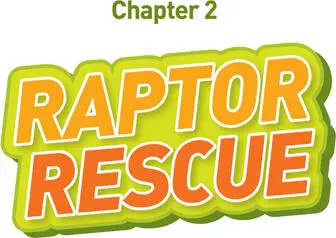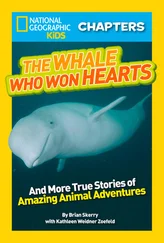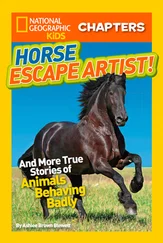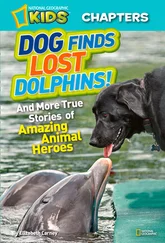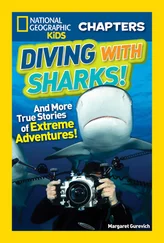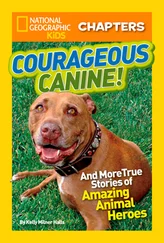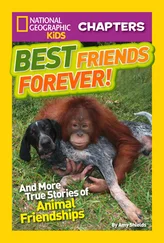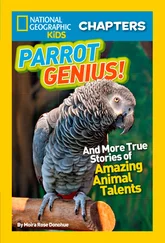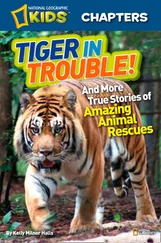
Owls live on every continent except Antarctica. They come in many shapes and sizes. The Eurasian (sounds like yur-AY-zhun) eagle-owl can grow to more than two feet (0.6 m) tall. It can weigh up to ten pounds (4.5 kg). The elf owl only grows to around six inches (15 cm) tall. It weighs less than half as much as this book. Owls’ feathers help them blend into their habitats. The snowy owl’s thick white feathers hide it from enemies in the frozen Arctic. And the gray- and rust-colored feathers of a screech-owl make it seem to disappear next to a tree.
Eurasian eagle-owl( photo credit 1.1)
“If we find baby squirrels or baby raccoons, we try to rescue them,” Homer says. “We find a lot of squirrels.” When the boys spot these animals, they call their mother for help. “She raises them until they are old enough to care for themselves,” says Homer. Then Mrs. Kuhn returns the animals to the wild.
Mrs. Kuhn has raised and released many squirrels over the years. But screech-owls were different. She had never cared for screech-owls. In fact, it is illegal to raise them in West Virginia. But these babies needed help.
Mrs. Kuhn got in her car and drove to the edge of the woods. “I really didn’t know what to do with baby screech-owls, but I didn’t want them to die,” says Mrs. Kuhn. She called everyone she knew, trying to find a rescue center that could take them. Meanwhile, she drove the owlets back to her house. She put them in a box with a heating pad to keep them warm, and she did her best to feed them.
Did You Know?
There are more than 200 species (sounds like SPEE-sheez), or kinds, of owls.
In the wild, baby screech-owls stay in the nest for about one month. Then they begin to learn how to fly and hunt. After that, the parents continue to protect and feed their young owls for two or three more months, until they can hunt on their own. But the baby owls’ eyes were still closed. They were less than a week old.
Owls are carnivores (sounds like CAR-nuh-vors). They eat meat. The owlets’ parents would have fed the babies insects and small mammals, like mice. All Mrs. Kuhn had was frozen hamburger and deer meat. She thawed the meat and cut it into small chunks. Then she used tweezers to feed the meat to the “baby hooters,” as she called the owlets. She called them this because of the sound adult screech-owls make: Hoot, hoot!
Did You Know?
Different kinds of owls make different noises. Owls can purr, chirp, bark, whistle, screech, whinny, and—of course—hoot.
The hungry owlets snatched the meat from the tweezers and swallowed the chunks whole. When their bellies were full, they tucked their heads into their feathers and fell asleep.
But soon, the babies lifted their beaks into the air again. Peep, peep! they cried, begging for more food. All through the night, Mrs. Kuhn fed the baby hooters. She gave them water through an eyedropper, too. Eat, drink, sleep. Eat, drink, sleep. It went on like this for two days.
What Mrs. Kuhn didn’t know is that owls need to eat bones, hair, and feathers, too. In the wild, the owlets’ parents would have fed them the entire animal. Bones and hair help owls cough up pellets. Pellets are hard lumps the size of peanuts. They are full of the things that owls cannot digest. If owls don’t cough up pellets every day, they can get sick. The baby hooters were not coughing up new pellets. Soon they lost energy. If Mrs. Kuhn did not find the owlets help soon, they would surely die.

Paul, on the top branch, looks ready to test his wings. Babe is not so sure. ( photo credit 1.2)
Finally, Mrs. Kuhn had an idea. She called the Maryland Department of Natural Resources, or DNR. They knew someone who could help! The next morning, Mrs. Kuhn drove the owlets to the DNR. Workers there helped get the babies to the Owl Moon Raptor Center in Boyds, Maryland, U.S.A. Raptors are birds of prey, such as eagles, hawks, and owls. They use their hooked beak and sharp talons (sounds like TAL-uns), or claws, to hunt other animals for food.
Suzanne Shoemaker runs Owl Moon out of her home. Her house sits in a patch of wooded land. Blue herons, ducks, and beavers live around a stream winding through the woods. Foxes slink across the grass.
Suzanne is a wildlife rehabilitator (sounds like ree-uh-BILL-uh-tay-ter). She has a special permit to care for hurt and orphaned raptors. She opened Owl Moon in 2002. She built two outdoor flight cages, called mews (sounds like MYOOZ), for the raptors. Once the birds are healthy, Suzanne keeps them in the mews until they are strong enough to be released back into the wild.
Suzanne turned one room of her basement into an indoor mew. She covered the windows with netting, so the birds could not fly into the glass or out an open window. And she put tree branches around the room to give the birds a natural place to perch, or stand. Suzanne wanted the mew to feel like the birds’ wild home.
Two adult screech-owls live in the indoor mew: Root’n Toot’n, a female, and Henry, a male. They play an important role at Owl Moon. They act as foster parents to baby owls that come to the center. Soon Root’n Toot’n and Henry would meet the new owlets. First, Suzanne needed to get the babies healthy.
As soon as the owlets arrived, Suzanne carried them down to the basement. She placed the owlets on a table. Then she looked them over from beak to claw. The owlets were a healthy weight. But something was wrong.
The babies had not coughed up pellets in two days. They had no energy, and they were dehydrated (sounds like dee-HYE-drate-id). This means that their bodies weren’t getting enough water. “Tammi Kuhn did the best she could caring for the owlets,” said Suzanne. “But they weren’t getting a good diet.” Now it was up to Suzanne to save them.
Suzanne sprang into action. She used a syringe (sounds like suh-RINJ) to inject fluid under the owlets’ skin. The fluid was like a clear sports drink for birds. This helped rehydrate them.
Next, Suzanne cut a dead mouse into small chunks. Suzanne calls this tasty bird treat “mouse mush.” It includes the meat, the bones, and the organs, too. The bones would help the owlets cough up pellets. Suzanne fed the babies mouse mush, using hemostats (sounds like HEE-muh-stats). Hemostats look like a pair of long, dull scissors.
Did You Know?
An eastern screech-owl can swallow a whole mouse in one gulp.
Finally, Suzanne put the babies inside an incubator (sounds like ING-kyuh-bay-tur). An incubator is a clear box. A fan pushes warm air inside the box. “At this point, the owlets needed to be kept warm, given fluids, and fed a proper diet,” Suzanne said.
Raising baby raptors is hard work. If you want to release them, it is important that the birds do not imprint on, or become attached to, humans. If a wild raptor thinks humans are friendly, it might try to approach them. This would put the bird and humans in danger. Imagine if a hawk crashed your picnic! To make sure the owlets did not imprint on her, Suzanne wore a special outfit called a ghillie (sounds like GILL-ee) suit. It looks like it is made of leaves or moss. The suit covers the entire body. It camouflages (sounds like KAM-uh-flazh-es), or hides, a human’s smell, too.
Читать дальше



